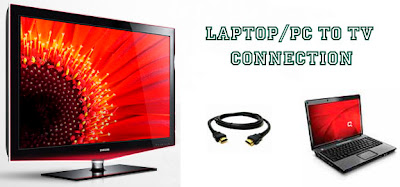
Cable Connection Setup
There may be more than one way for you to hookup your laptop/PC to the TV, based on the information discussed in the previous posting on Cable connections. However, I am going to take a look at two of the more popular ones:
1. HDMI/DVI Connection.
2. VGA Connection.
Before proceeding with the discussion of these two approaches, I want to state the following:
1. That the graphics card on your laptop/PC has the lastest driver installed. [If not, use the Device Manager in the Windows Control Panel to access the card and update its device driver].
2. That it is assumed that both your laptop/PC and LCD TV are powered off, before you start connecting cables.
HDMI/DVI Cable Connection
Today, HDMI ports are very common on LCD TVs, but less common on your Laptop/PC up until recently. Therefore, many people use a HDMI/DVI connection between their laptop/PC and their LCD TV. That is, a HDMI/DVI cable (see image below), is used to connect to a HDMI port on the TV end and to a DVI Port on the laptop/PC side.

Since a HDMI/Cable only carries a video signal, we will also need a 3.5mm mini-stereo-to-RCA cable (as shown below).
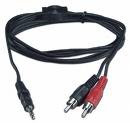
Moving on...
First, let's take a look at the connection panel of a typical LCD TV. The schematic below will be somewhat similiar to the one for your LCD TV [Click on the image to enlarge]. Nowadays, a LCD TV comes with the cable connections described in the previous section (i.e. HDMI, S-Video, VGA, RCA, etc.).
For the purposes of describing the HDMI/DVI Connection setup, we are interested in the HDMI2 port (labelled # 4).

Step 1: Connect the HDMI/DVI cable between the HDMI IN 2 port on the TV and the DVI output port on your computer.
Step 2: Connect the 3.5 mm Stereo mini-plug/2RCA Cable between the DVI IN(HDMI2) [R-AUDIO-L] port on the TV and the Audio Out jack of the on your Laptop/PC.
Note: This is not an option if your laptop/PC does not have a DVI output port.
Look at the schematic below [Click on the image to enlarge]:

Fairly simple to connect, eh? However, there some display settings (laptop/PC and LCD TV), that we need to cover in order for this to work properly. This discussion is at the end of this post below.
VGA Cable Connection
All laptops/PCs come with a VGA connection and so do the LCD TVs. For the purposes of hooking up the laptop/PC to the TV, we will need a D Sub cable that has male VGA connectors at both ends (as shown below).
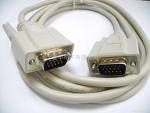
Step 1: Connect a D-Sub Cable between PC IN [VGA] connector on the TV and the VGA output port on your laptop/PC.
Step 2: Connect a mini Audio Cable between the PC IN [AUDIO] jack on the TV and the Audio Out jack on your laptop/PC.
Look at the schematic below:
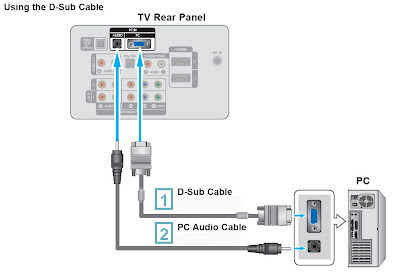
Again, fairly straight-forward. Now, in the subsection below, we will discuss what laptop/PC and TV settings need adjustment or modification, so we can complete the connection setup.
Laptop/PC and LCD TV Settings
Regardless of the type of cables you use to physically connect your laptop/PC to your LCD TV, there are some settings on both the laptop/PC and LCD TV ends that are required for this connection to work properly. Due to the variety of laptops/PCs and LCD TVs, the setting adjustments will vary slightly. However, I am going to give a general description of these settings.
First, turn on your LCD TV and then power up the laptop/PC. The laptop/PC should come up in the usual way with the Windows Desktop displayed. However, the LCD TV may have a blank screen or is tuned to one of your regular TV channels.
We must first change the source input for the LCD TV by using the TV INPUT button on your TV remote or the button on the actual TV itself. By scrolling down through the options, select the input option as follows:
- For the HDMI/DVI connection, choose HDMI2.
- For the VGA connection, choose PC (possibly listed as VGA).
After making this switch, the Windows Desktop may or may not be displayed on your LCD TV. Don't worry if it is not displayed at this stage, as we have to make further display setting adjustments on the laptop/PC.
Typically, most laptops/PCs have one of the following types of graphics cards:
- Nvidia Graphics Card.
- ATI Graphics Card.
- Intel Graphics Card.
Anyways, we need to bring up the Control Panel interface*, for the particular graphics card installed in the laptop/PC and make the following adjustments:
1. Setup for multiple displays.
2. Resolution and Refresh Rate.
*Note: In Windows XP/Vista, the Control panel can be brought up by doing a right-click of the mouse button on the Desktop area and choosing the Control Panel from the menu listings.
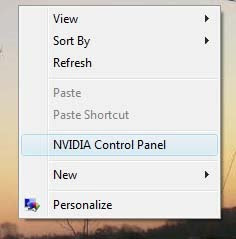
Figure 1: NVIDIA Control Panel Selection
Please note at this stage, your laptop/PC may have already automatically detected and adjusted the resolution for the new LCD TV display. Regardless, the laptop/PC-to-TV connection may have resulted in over-scanning (where the Windows screen goes beyond the TV screen) or under-scanning (where the Windows screen is much smaller that the TV screen). There are setting options in the Control Panel that will allow you to compensate for over- or under-scanning.
Next, we want to setup how we use the two displays (laptop/PC and the LCD TV). Typically, we use one of the following:
1. Clone (this option mirrors your Windows desktop on the LCD TV display). It is a good option when you are using your TV as a display for presentations.
2. DualView (this option extends your Windows Desktop desktop display area to the newly connected TV). It is a good option to use for playing DVDs, or watching online TV, as you can still you use your laptop/PC for other computer tasks and at the same time, your Media Player can be running on the TV display.
Again, there are setting options in the Control Panel for this setup.
The Refresh Rate should be set to 60 Hertz. At this time, a rate greater than 60 Hz may cause damage to your LCD TV screen. However, I am aware that some of the new LCD TVs coming on the market now, can accommodate refresh rates up to 120 Hertz.
Next, the resolution on your LCD TV maybe out of whack and that the TV display is not that clear or has a view that is not nice for the eyes. If this is the case, you will need to do some resolution adjustments (also, an option in the Control Panel).
Disclaimer: Some further minor adjustments maybe be required for your specific laptop/PC-to-TV setup, but this is only a general guide. You should consult your LCD TV manual and graphics card manual for further tweaking of the settings.
At this point, you should have an acceptable display on your LCD TV. If not, then unfortuantely, you will have to do some troubleshooting. I don't have any specific troubleshooting tips right now, but as I come across some I will add them to the Troubleshooting Tips section below.
Troubleshooting Tips
To be added.
Part 3 of this posting covers my actual experience(s) of connecting my laptop to the LCD TV.
HowTo Guideline Part 3/3>>
Previous>>
___




No comments:
Post a Comment